
PBBS
19
PBBS
General
Your TNC contains the Kantronics Personal Mailbox system which will allow you to leave messages
for others which may be retrieved later. The personal mailbox is compatible with the large com-
munity bulletin board systems (RLI, MBL, etc.) and will allow them to forward mail for you directly
into your TNC. You may also place Personal or NTS type messages into your mailbox, and if the lo-
cal Community BBS system allows, your TNC mailbox will forward these messages from your per-
sonal mailbox into the community system on request.
Configuring your PBBS
In order to enable your PBBS, you must set the MYPBBS callsign to be a unique callsign – that is, it
cannot be the same as any other callsign in your TNC. You must also set the PBBS size, to allocate
some RAM memory to the mailbox. This is accomplished with the PBBS command. The maximum
setting allowed will depend on the amount of memory available. NUMNODES, MAXUSER and
NAVSTA (
KAM
) will affect the amount of memory available.
If you change the size of the mailbox, the TNC will not renumber any exiting messages. If the new
size is large enough for all existing messages, no messages will be lost. To renumber the mes-
sages, specify PBBS
n
with
n
being the current size. All messages will be renumbered starting with
the number 1.
At times, you may be away from your computer and would like to switch a user into your mailbox
automatically if he connects to your MYCALL. This can be accomplished by setting the CMSG com-
mand to PBBS. In order for this to operate, you must also have some message in the CTEXT. When
this is done, a user who connects to your MYCALL will be sent your CTEXT first. Then, when the
TNC receives the acknowledgment for the CTEXT, the user will be automatically connected to the
PBBS. The TNC will then send the normal PBBS sign on message, the PTEXT (if any) and the PBBS
prompt. The sign-on message is enclosed in square brackets and consists of the unit name, firm-
ware version and H for support of hierarchical forwarding. Example:
[KAM-3.0-H]
If it becomes necessary to disconnect a station from your PBBS, you can use the local terminal
connected to your TNC to accomplish this (see DISCONNECT MYPBBS). If a station connects to
your PBBS and no activity occurs on that connection for 15 minutes, the PBBS will automatically
disconnect the user, in order to make your PBBS available to other users.
Using the PBBS
In order to use any TNC PBBS (even your own) first, get the
cmd:
prompt on your TNC and then
connect to the callsign of the PBBS. For instance, if MYPBBS is DC7XJ-1 I would simply type
C DC7XJ-1
. Since the PBBS is in my own TNC, no packets would be transmitted, but I would con-
nect to the PBBS and receive the same prompt as if I had connected to someone elses PBBS.
When you connect to a TNC PBBS, you will first see the message from your TNC indicating that
you are connected –
*** CONNECTED TO DC7XJ-1
. The PBBS will then send you its initial sign
on message. If you have defined a PTEXT, the TNC will send it as the next line and then it sends
the PBBS command prompt. Example:
*** CONNECTED TO DC7XJ-1
[KAM-3.0-H]
PTEXT would be here (if any)
ENTER COMMAND: B,J,K #, KM,L,LM,R #,RM,S, or Help >
















































